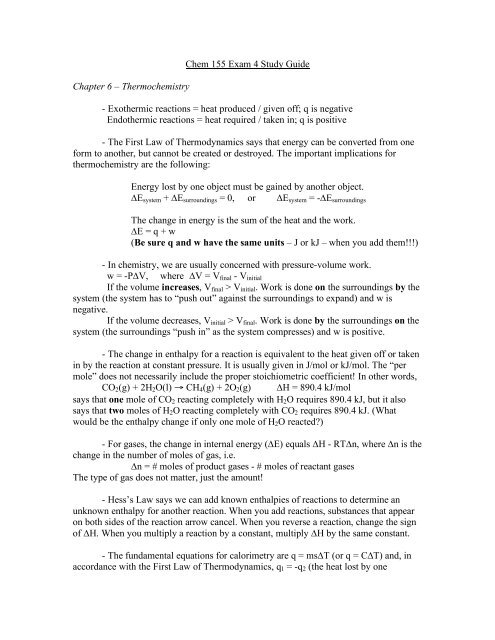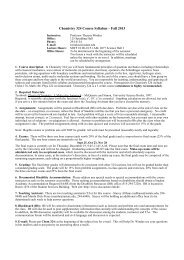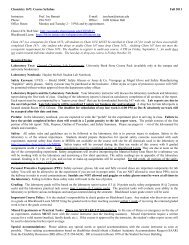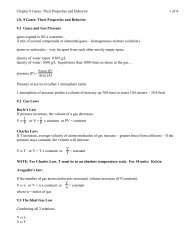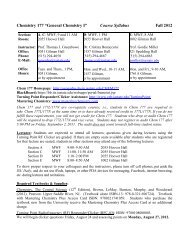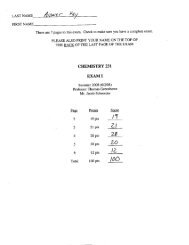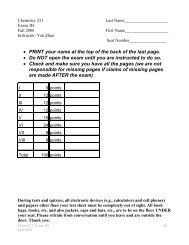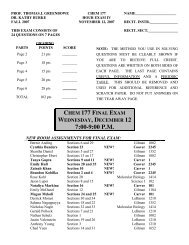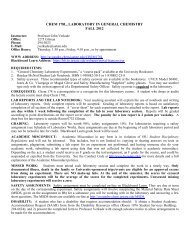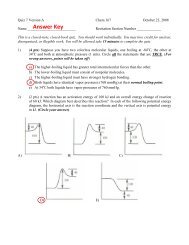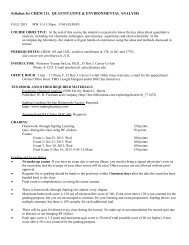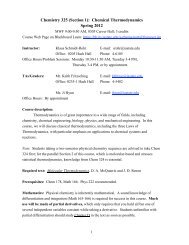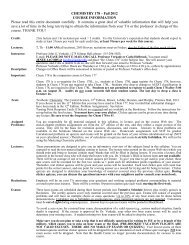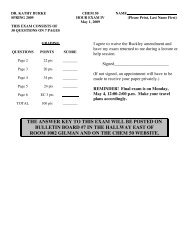Chem 155 Exam 4 Study Guide Chapter 6 – Thermochemistry ...
Chem 155 Exam 4 Study Guide Chapter 6 – Thermochemistry ...
Chem 155 Exam 4 Study Guide Chapter 6 – Thermochemistry ...
Create successful ePaper yourself
Turn your PDF publications into a flip-book with our unique Google optimized e-Paper software.
<strong>Chapter</strong> 6 <strong>–</strong> <strong>Thermochemistry</strong><br />
<strong>Chem</strong> <strong>155</strong> <strong>Exam</strong> 4 <strong>Study</strong> <strong>Guide</strong><br />
- Exothermic reactions = heat produced / given off; q is negative<br />
Endothermic reactions = heat required / taken in; q is positive<br />
- The First Law of Thermodynamics says that energy can be converted from one<br />
form to another, but cannot be created or destroyed. The important implications for<br />
thermochemistry are the following:<br />
Energy lost by one object must be gained by another object.<br />
∆E system + ∆E surroundings = 0, or ∆E system = -∆E surroundings<br />
The change in energy is the sum of the heat and the work.<br />
∆E = q + w<br />
(Be sure q and w have the same units <strong>–</strong> J or kJ <strong>–</strong> when you add them!!!)<br />
- In chemistry, we are usually concerned with pressure-volume work.<br />
w = -P∆V, where ∆V = V final - V initial<br />
If the volume increases, V final > V initial . Work is done on the surroundings by the<br />
system (the system has to “push out” against the surroundings to expand) and w is<br />
negative.<br />
If the volume decreases, V initial > V final . Work is done by the surroundings on the<br />
system (the surroundings “push in” as the system compresses) and w is positive.<br />
- The change in enthalpy for a reaction is equivalent to the heat given off or taken<br />
in by the reaction at constant pressure. It is usually given in J/mol or kJ/mol. The “per<br />
mole” does not necessarily include the proper stoichiometric coefficient! In other words,<br />
CO 2 (g) + 2H 2 O(l) → CH 4 (g) + 2O 2 (g) ∆H = 890.4 kJ/mol<br />
says that one mole of CO 2 reacting completely with H 2 O requires 890.4 kJ, but it also<br />
says that two moles of H 2 O reacting completely with CO 2 requires 890.4 kJ. (What<br />
would be the enthalpy change if only one mole of H 2 O reacted?)<br />
- For gases, the change in internal energy (∆E) equals ∆H - RT∆n, where ∆n is the<br />
change in the number of moles of gas, i.e.<br />
∆n = # moles of product gases - # moles of reactant gases<br />
The type of gas does not matter, just the amount!<br />
- Hess’s Law says we can add known enthalpies of reactions to determine an<br />
unknown enthalpy for another reaction. When you add reactions, substances that appear<br />
on both sides of the reaction arrow cancel. When you reverse a reaction, change the sign<br />
of ∆H. When you multiply a reaction by a constant, multiply ∆H by the same constant.<br />
- The fundamental equations for calorimetry are q = ms∆T (or q = C∆T) and, in<br />
accordance with the First Law of Thermodynamics, q 1 = -q 2 (the heat lost by one
substance must be gained by another substance, since we assume the calorimeter is an<br />
isolated system from which no energy can escape). This could be q reaction = -q calorimeter or<br />
q metal1 = -q metal2 or q reaction = -(q calorimeter + q water ) <strong>–</strong> you must be able to identify what<br />
component of the system is losing heat and what other component(s) will gain the heat.<br />
<strong>Chapter</strong> 7 <strong>–</strong> Quantum Theory<br />
- Know the meaning of the wavelength (λ) and frequency (ν). Know how the two<br />
are related: λν = a constant, which is c = 3.00x10 8 m/s in the case of light waves. Know<br />
the units associated with frequency (Hz, cycles/second or simply s -1 ) and wavelength (m<br />
or nm or some other prefix in front of m).<br />
- Know the relation between energy and frequency: E = hν where h is Planck’s<br />
constant.<br />
- Be able to describe the photoelectric effect and its importance in the<br />
development of quantum theory (i.e. to explain the photoelectric effect, Einstein<br />
postulated that light has both a wavelike and a particle-like nature, an idea previously<br />
unheard-of).<br />
- In fact, everything has a dual wave/particle nature, including matter. The<br />
wavelength associated with a quantity of matter is called the de Broglie wavelength. It is<br />
very, very small for macroscopic objects (which is why we don’t notice it in day-to-day<br />
life) but is significant for particles like electrons, which are “smeared out” in space.<br />
(What does this have to do with the Heisenberg Uncertainty Principle?)<br />
- Know what atomic emission lines/spectra are, and what causes them<br />
- Know your quantum numbers<br />
- Know how to fill an orbital energy level diagram, and how to write the shorthand<br />
notation for electron configuration (e.g. 1s 2 2s 2 2p 6 …)<br />
- Diamagnetic v. paramagnetic<br />
- Bohr’s model of the atom was able to explain the atomic spectrum of hydrogen,<br />
but failed for multi-electron atoms. Why? (Compare Figure 7.22 on page 291 to Figure<br />
7.23 on page 292. Note that, in 7.22, the energy levels are arranged very regularly and<br />
predictably, corresponding to “orbit radii” in the Bohr model. In 7.23, for multi-electron<br />
atoms, splitting of the orbital energy levels occurs and does not correspond to anything<br />
predicted by the Bohr model. What is responsible for this splitting? What does this have<br />
to do with orbital shape? How does this disprove the Bohr model’s theory about the<br />
shapes of orbitals?)
<strong>Chapter</strong> 8 <strong>–</strong> Periodic Relationships<br />
- Know the meaning of and trends for: atomic radius, ionic radius, electron<br />
affinity, ionization energy<br />
- Be able to write the electron configuration for ions (and remember that electrons<br />
are first removed from the furthest out s orbital when forming transition metal cations,<br />
not from the outermost d orbital)<br />
- Be able to identify when two atoms/ions are isoelectronic<br />
- Know the meaning of the term “valence electrons”


